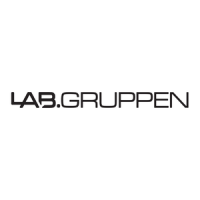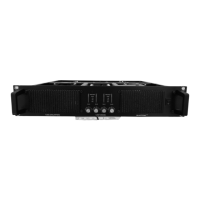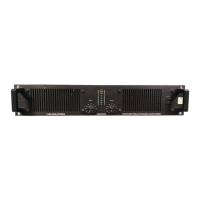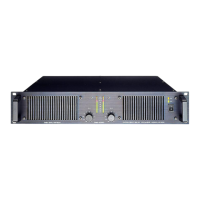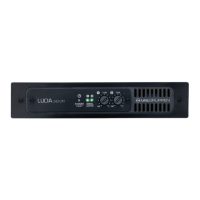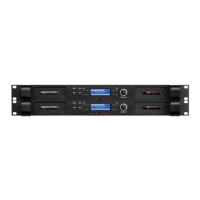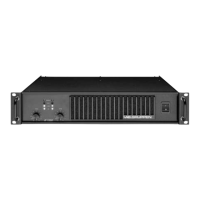Please refer to diagram on page 3
1. Speaker connector
This type of speaker connector may be
unfamiliar to some users. A full description is found
in the operation section. (See page 6).
2. Clip limiter switch.
Turns the clip limiter on and off.
3. Input jack
Alternative to using input XLR or for linking
inputs with other amplifiers. (See page 5).
4. Input signal XLR (See page 5).
5. Phase reverse switch for channel B
For reversing the input signal phase of channel
B to allow bridged operation. (See page 7).
6. Link switch
Allows a single input to drive both channels
simultaneously. (See page 7).
7. Gain select switch
Allows amplifier gain to be switched between
29dB and its normal gain at 0.775mV input
sensitivity. (See page 7).
8. AC line cord (See page 5).
Installation
1. Mounting
The amplifier is two rack units high (2U) and will
mount in a standard EIA 19 inch rack. Amplifiers
may be stacked directly on top of each other. There
is no need for spacing between units. If it is the
intention to fill a rack with amplifiers, we
recommend racking is started from the bottom of
the rack. It is also recommended that rear supports
are used for amplifiers mounted in the middle of the
rack, especially if used as part of a portable system.
2. Cooling
Your amplifier uses forced air cooling system to
maintain a low and even operating temperature. All
LAB.GRUPPEN amplifier, which are fan
ventilated, have front to rear cooling. There are
several reasons for this, one is that there's usually
cooler air outside the rack than inside and therefore
the amplifiers can run at higher continuos power
levels without thermal problems. Never try to
reverse the air flow, as the Intercooler® need a
pressure chamber between the fans and heat sink,
and this only works in one direction of the air flow
(see Design features on page 8).
Should a heat sink get too hot, its sensing circuit
will mute the hot channel.
Make sure that there is an adequate air supply in
front of the amplifier and that the rear of the
amplifier has sufficient space to allows the exhaust
to escape. If the amplifier is rack mounted, do not
use covers or doors on the front or rear of the rack.
For fixed installations with a central cooling
system, usually found in fixed installations with a
dedicated rack room, it may be necessary to
calculate the maximum heat emission. Refer to
Power consumption on page 5.
3. Operating voltage
A label just below the mains cable on the rear of
the amplifier indicates the AC mains voltage, for
which the amplifier is wired. Connect the power
cable only to the AC source referred to on the label.
The warranty will not cover damage caused by
connecting to the wrong type of AC mains.
For converting a 230 volt amplifier to 115 volt or
vice-versa, see Appendix A.
The amplifier is supplied with an approved European
AC line connector. If this connector is not
appropriate for your country, it can be cut off and
wired to a suitable connector in the following way :
BROWN LIVE
BLUE NEUTRAL
GREEN/YELLOW EARTH
Once the AC connector is connected to a suitable AC
supply, the amplifier can be started with the AC
actuator.
When you power up the amplifier, the fans then blow
at high speed before going onto "idle" and the 2
bottom green LED’s come on to show the output
circuits are receiving the correct rail voltage.
4. Grounding
There is no ground lift switch or terminal on this
amplifier. The signal ground is always floating via a
resistor to chassis and the grounding system is
automatic. If a potential above 0.6V presents itself
between signal ground and chassis ground, a short
circuit is introduced between the two, thereby
enabling electrical protection. If a unit in the system
is faulty, its mains fuse will blow, due to this
automatic ground system.
If however you wish to tie the signal ground to
chassis, connect the XLR-connector’s shell lug to
pin 1. In the interest of safety never disconnect the
earth pin on the AC cord.
For all units that are EMC approved (radio
interference), there is an AC mains filter. This filter
4

